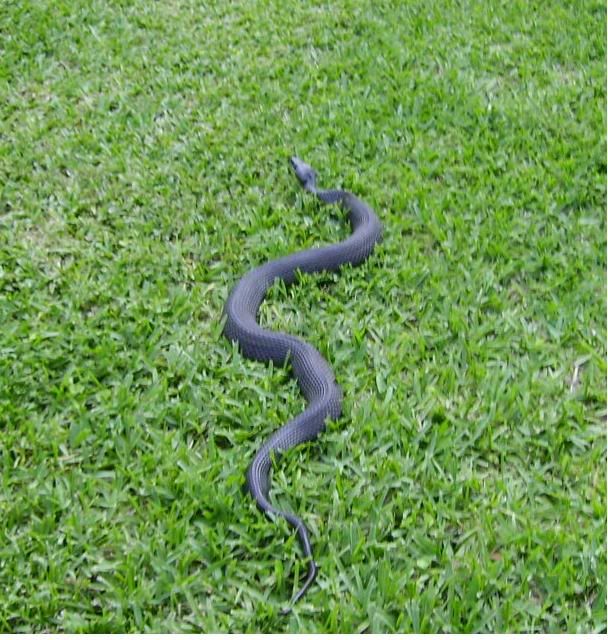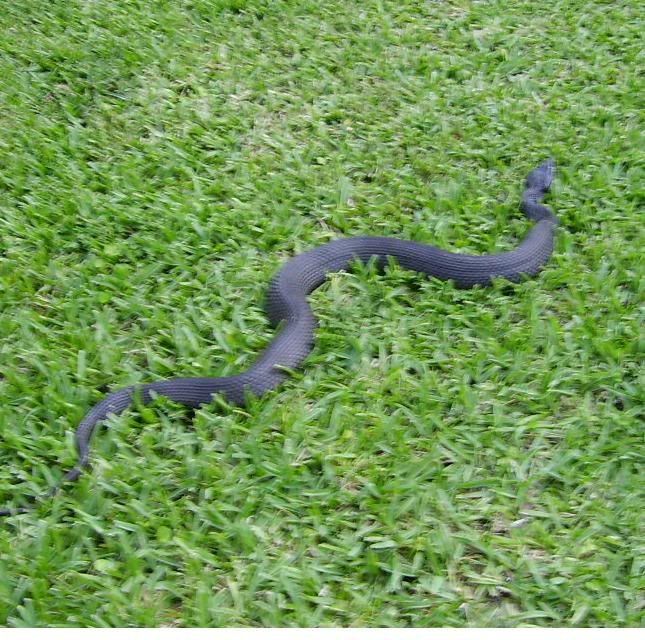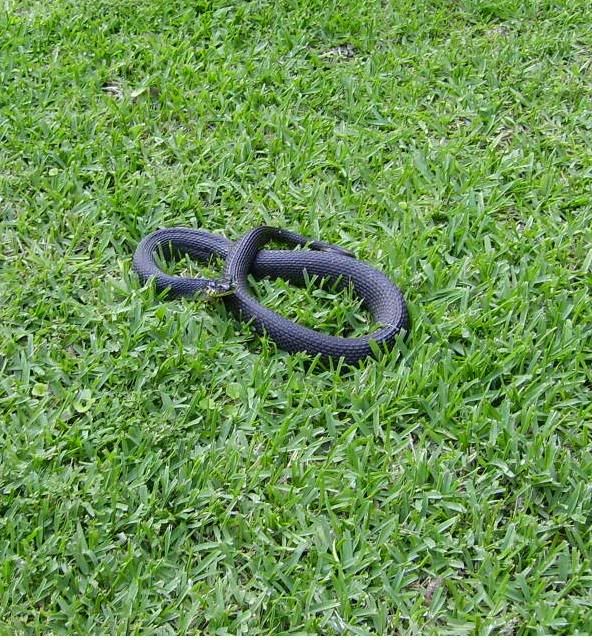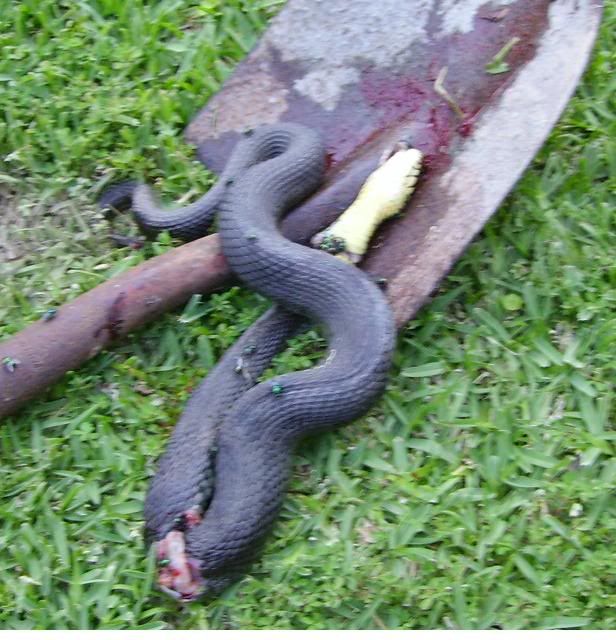
Posted on 05/09/2009 5:27:52 PM PDT by humblegunner
This afternoon I happened to look out the back and saw something
black and long in the middle of the yard. I just mowed yesterday
so I knew the yard was free of sticks and such.
Turns out it was a big black snake!
He isn't a rattler, does not look loke a water moccasin or a black snake.
What the heck kind of snake is he? He has the triangular head which
means he is a bad one, but I can't place his breed.
Anyway, photography being as dangerous as it is, he got wrecked up some
which is just as well. He might have bitten one of the animals.





So who knows any herpetology?
Agree...... we don’t kill for the fun of it aside from fuzzy bowling pins and even that is to keep the cattle from breaking a leg. Game we kill is harvested and used or shared with less fortunate neighbors and friends.
as it should be.....;o)
Looks like a dead snake to me.
LMAO ! agree..... If it rattles or scares my horse it gets shot !
First of all, why did you kill it? I never see snakes anymore, sigh ...
Brother, I don't know and I'm not going to find out. The snakes I've killed were all cotton mouths/Moccasins (as I highly suspect this one was as well).
Pit Viper's are mean, mean, mean. Plus, they can strike at least the length of their body, and I believe some can strike 1.5 times the length of their body. I'm not going to take the chance with a BB or Pellet gun. It's double-ought buck or nothing for me.

Agkistrodon piscivorus leucostoma is a venomous pitviper subspecies[4] found in the south central United States. It is the smallest of the three subspecies tends to be darker in color.
Common names: western cottonmouth,[2] water moccasin, cottonmouth,[3] more.
http://en.wikipedia.org/wiki/Agkistrodon_piscivorus_leucostoma
__________________________________________
How to Spot a Cottonmouth Snake
The Cottonmouth is the only poisonous water snake found in North America. It is a pit viper and senses movement with its pit in between its eyes. The Cottonmouth snake is found in three subspecies. The Western Cottonmouth, the Eastern Cottonmouth, and the Florida Cottonmouth have common characteristics and traits that distinguish them from nonvenomous water snakes.
http://www.ehow.com/how_2090701_spot-cottonmouth-snake.html?ref=fuel&utm_source=yahoo&utm_medium=ssp&utm_campaign=yssp_art
__________________________________________
How to Identify a Pit Viper
1) Know the pit vipers range and habitat. A pit viper is one of the widest reaching groups of snakes in the world. They are found throughout the Americas, as well as Asia. They can survive in the hottest deserts, as well the wettest rain forest. Pit vipers are very adaptable snakes.
2) Realize that in North America, there are three major species of pit vipers. They are the cottonmouth, copperhead and rattlesnakes.
3) Observe that pit vipers can range in size from less than 30 cm all the way up to 12 feet long. An average size for a pit viper is probably around 5 feet long.
4) See that a pit viper has a heat sensing organ between its eye and nostril. This pit is the major feature that sets pit vipers apart. It allows the snake to sense heat. Some refer to this as a sixth sense.
5) Compare a pit vipers fangs to a rear fanged species such as the cobra. A pit viper folds its fangs under and back into the roof of its mouth. A cobra has fixed fangs that do not fold. The pit viper will extend the fangs out when it strikes in a stabbing motion, burying venom deep within its prey.
6) Observe that a pit viper's head is often triangular in shape, and is markedly wider than the neck of the snake. This is often due to the large venom glands in the snake's jaw. These glands also contain an extra muscle that allows for delivery of the venom through the fangs.
7) Know that pit vipers are generally give birth to live young as opposed to many other snake species that lay eggs. This allows the pit viper to deliver large amounts of young in a single birthing.
I live in New York City. Not too much of a snake problem here. Rats, roaches and pigeons, yes, but not snakes.
In the morning, go out and see if you can pull up some fangs out of his mouth? His head seems intact enough.
You’ve probably been told this countless times by now, but...looks like a Cottonmouth to me. Called in husband to look at the pics. He says Cottonmouth too. Glad you saw it before your pets did.
You know the rules, if you kill’um, you got to eat’um.
He is thick, I bet he tastes good.
Don’t know where you live, but consider the possibility of it being a brown rat snake, which can be black in color and even comes in peculiar light and dark color patterns. I once saw one in S.E. Minnesota that was 5-6 ft. long and yellow with scattered black stripes curving around its body in a random pattern.
If you ever get down this way, stop by, I’ll hook you up with all the bar-b-q you could ever want (and cold beer).
We could even go across the road to our snake infested pond. I’ve got an extra 22 for you to use. Might be a hell of a time.
You advocate killing all pitbulls but killing snakes is wrong?
Hypocrite.
You want ME to travel from New York to Texas TONIGHT to check out that friggin snake by tomorrow morning?? Not unless YOU pay the airfare!
((joshing)) :)
doesn’t look poisonous. The head on a poisonous one is much more triangular in shape.
I’ve seen Northern Water Snakes that look like that...but he’s a good snake now.
Sounds great! I’ll bring a little Rat-atouille from New York.
Whatever it was, it probably tastes like chicken.
I’m leaning yellowbellied. It just wasn’t cantankerous to be a moccasin, and I’ve ran across at least a hundred.
Moccasins don’t run, they run AT you, flashing their mouth the whole time.
And they’re fat from head to (especially) butt, with short, skinny tails.
The one TX way is to smell it. Moccasins stink to hell - an undescribably rank, putrid scent that no other live snake possesses. If HG’s snake has no scent, it’s probably not a moccasin.
Disclaimer: Opinions posted on Free Republic are those of the individual posters and do not necessarily represent the opinion of Free Republic or its management. All materials posted herein are protected by copyright law and the exemption for fair use of copyrighted works.